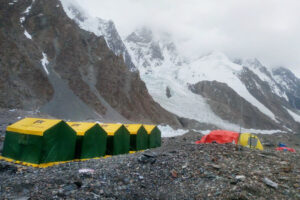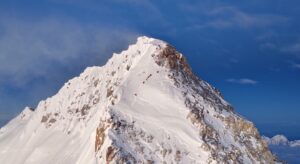Climbing an 8,000’er in winter is not the same but colder, explains Dr. Robert Szymczak of Poland. A veteran high-altitude climber and rescuer, Szymczak has taken part in three winter expeditions with Poland’s national climbing team, has summited three 8,000’ers, and is a researcher in high-altitude medicine. Here, he offers his unique insight into what it takes to climb the world’s highest peaks in winter.

K2 on a windy winter day. Photo: Alex Txikon
Peaks “grow” in winter
In one long-term study, Szymczak and his fellow researchers assessed conditions at the summits of Everest and K2 every month from 1979 to 2019. They then analyzed the differences between climbing in spring or summer versus winter.
“Our main finding is that the barometric pressure, and therefore the available oxygen, dramatically decreases in winter,” says Szymczak. “Interestingly, the decrease is more pronounced in the Karakoram than in the Himalaya.”
He backs up this conclusion with the numbers.
“During the climbing season [May for Everest, July for K2], the barometric pressure is 333hPa on the summit of Everest and 347hPa on K2,” he says. “These values correspond to a perceived altitude of 8,925m on Everest and 8,640m on K2. In winter, [January and February], the barometric pressure significantly drops to 324hPa on Everest and 326hPa on K2. This corresponds to a perceived altitude of 9,134m on Everest and 9,095m on K2.”
This means that the level of oxygen on the summits of Everest and K2 in winter is as low as it would be at an altitude of around 9,100m during the climbing season.
“To experience the same oxygen deficit as on Everest and K2 in winter, a climber who summits Everest without oxygen in May would have to climb 200m more,” he says. “Our body perceives Everest and K2 in winter as 9,000’ers.”

Climbing Broad Peak in winter 2008-09. Photo: Robert Szymczak
Specific acclimatization for winter
The extremely thin air on the summit of Everest and K2 in winter means that any potential winter climber needs even better acclimatization than usual to deal with the greater risk of acute altitude sickness and the slower pace during the summit push.
The researchers also studied the acclimatization profiles of climbers who summited Everest in spring without supplementary oxygen. They conclude that climbers planning winter ascents on Everest or K2 without O2 should reach 8,000m (Camp 4 on both K2 and Everest’s south side) on their last rotation before a summit push. Weather windows are scarce in winter, so climbers may not have a chance to acclimatize fully on their chosen route. Instead, they may want to consider acclimatizing on other peaks before winter begins.
This is what Jost Kobusch and Simone Moro are doing. Kobusch climbed two virgin 6,000’ers near Annapurna before heading for Everest. Moro is in the Khumbu, likewise aiming to scale another peak before attempting Manaslu.

Simone Moro and Tamara Lunger in a hypobaric chamber. Photo: Simone Moro
The researchers also recommend pre-acclimatizing at home in a hypobaric chamber like the one used by Simone Moro and Tamara Lunger before they attempted a winter Gasherbrum I–Gasherbrum II traverse. But Szymczak warns that some forms of hypoxia training and the hypoxia tents provided by some expedition agencies (normabaric hypoxia) may not improve acclimatization or reduce the risk of AMS. To be on the safe side, climbers using these tents should also follow the usual acclimatization protocols.
In addition, climbers should remember that they will climb more slowly in winter. Thus, they should budget more time to summit than in warmer months. Winter days are shorter too, so they should set off from their high camp much earlier to reduce the risk of an unplanned bivouac.
Colder Karakoram, windier Himalaya
During the normal climbing season on Everest and K2, air temperature and wind speed are similar: Typically, the air temperature is −26˚C on the summit of Everest and −21˚C on the summit of K2. Wind speed is 60kph on Everest and 55kph on K2.
“The situation changes dramatically in winter when the average air temperature is much lower in the Karakoram than in the Himalaya,” said Szymczak.
Everest, for example, averages −36˚C on its summit, K2 −45˚C. On the other hand, the average wind speed is much higher in the Himalaya. Everest is 150kph, K2 100kph.

A frozen Jost Kobusch in winter. Photo: @terragraphy
The Karakoram is colder in winter because it is more northerly. The higher wind speeds on Everest correspond with global jet-stream trends. In winter, the Northern Hemisphere’s jet stream splits over the Atlantic Ocean into the Subtropical jet stream and the Polar Front jet stream. At the longitude of the Himalaya and Karakoram, the Subtropical jet stream flows above the Himalaya between 20˚N and 35˚N.
The Polar Front jet stream flows between 40˚N and 70˚N. This leaves a 5˚ gap between 35˚N and 40˚N, precisely aligning with the Karakoram peaks. This explains the significantly lower (but still strong) winter winds on K2 compared to Everest.
To sum up, in winter, the combination of extremely low barometric pressure (which significantly slows climbing), low air temperatures, and high wind speeds put climbers on Everest or K2 at a remarkably high risk of frostbite, hypothermia, acute mountain sickness, and metabolic deterioration.

Szymczak on Nanga Parbat (in summer). Photo: ONET
Further reading
In a different study, Szymczak and his research team evaluated the weather in the Death Zone. They collected data from 528 no-O2 ascents of Everest and K2, as well as all winter ascents of 8,000m peaks, with and without supplemental O2. They compiled their results in the paper, Death Zone Weather Extremes Mountaineers Have Experienced in Successful Ascents. Those interested in thermoregulation will find useful information in another study, Heat Balance When Climbing Mount Everest.
Robert Szymczak is a medical doctor specializing in emergency medicine. He holds a PhD in mountain medicine and is a lecturer at the Medical University of Gdansk’s Department of Emergency Medicine and the Jagiellonian University in Cracow’s Medical Center for Postgraduate Education. Szymczak is also a rescuer for the Helicopter Emergency Medical Service in Gdansk, Poland. He has taken part in high-altitude expeditions for decades, as a physician and a climber (Mont Blanc, Elbrus, Lenin Peak, Chan Tengri, Passu Sar, Island Peak, Lobuche East, Nanga Parbat, Dhaulagiri, Broad Peak, Mount Everest).






